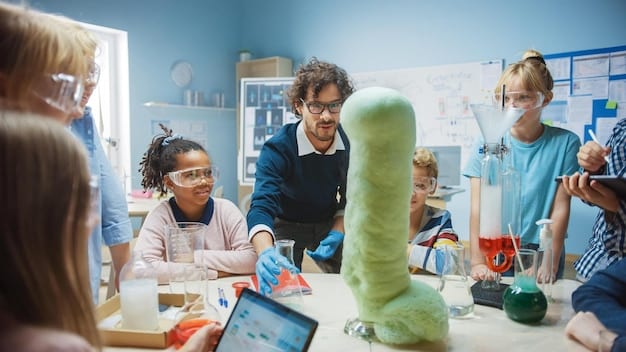Social-Emotional Learning Integration: Boosting Student Success

Social-Emotional Learning (SEL) integration enhances students’ well-being and academic performance by fostering crucial skills such as self-awareness, self-management, social awareness, relationship skills, and responsible decision-making, leading to a potential 15% improvement in overall outcomes.
In today’s educational landscape, the focus extends beyond traditional academics to encompass the holistic development of students. Social-Emotional Learning (SEL) Integration: Improving Student Well-being and Academic Performance by 15% is rapidly gaining recognition as a critical component of effective education, fostering not only academic success but also crucial life skills.
Understanding Social-Emotional Learning (SEL)
Social-Emotional Learning (SEL) is the process through which children and adults acquire and effectively apply the knowledge, attitudes, and skills necessary to understand and manage emotions, set and achieve positive goals, feel and show empathy for others, establish and maintain positive relationships, and make responsible decisions. It’s a framework that equips individuals with the tools they need to navigate their emotions and social interactions successfully.
The Core Competencies of SEL
SEL is typically structured around five core competencies, each playing a crucial role in a student’s development:
- Self-Awareness: Understanding one’s own emotions, strengths, and weaknesses. Recognizing how emotions influence behavior.
- Self-Management: Regulating emotions, managing stress, and controlling impulses. Setting and achieving personal and academic goals.
- Social Awareness: Understanding the perspectives of others, empathizing with diverse backgrounds, and recognizing social norms.
- Relationship Skills: Building and maintaining healthy relationships, communicating effectively, and resolving conflicts constructively.
- Responsible Decision-Making: Making ethical choices, considering consequences, and taking responsibility for one’s actions.
These competencies are not isolated skills but rather interconnected aspects of a student’s overall development. When effectively integrated into the educational system, they can lead to significant improvements in both well-being and academic performance.
The Importance of SEL Integration in Education
Integrating SEL into the curriculum is crucial for creating a supportive and inclusive learning environment. It moves beyond traditional academic instruction to address the emotional and social needs of students, fostering a more well-rounded and prepared individual.

Creating a Positive Learning Environment
SEL integration helps create a classroom environment where students feel safe, respected, and supported. This positive atmosphere is conducive to learning and encourages students to take risks, participate actively, and engage with the material.
Addressing the Whole Child
By focusing on the development of social and emotional skills, SEL addresses the “whole child,” recognizing that academic success is intrinsically linked to emotional well-being and social competence. It acknowledges that students are not simply vessels for information but complex individuals with unique needs and experiences.
In conclusion, integrating SEL into education is vital for fostering a positive learning environment and addressing the holistic needs of students, contributing to their overall well-being and academic success.
Benefits of Social-Emotional Learning for Students
The benefits of SEL extend far beyond the classroom, impacting students’ lives in profound ways. By developing their social and emotional skills, students become more resilient, empathetic, and capable of navigating the challenges of life.
Here are some key benefits of SEL for students:
- Improved academic performance
- Reduced behavioral problems
- Increased emotional regulation
- Enhanced social skills
- Stronger relationships
SEL prepares students for future success by equipping them with the skills they need to thrive in college, careers, and life. These skills are highly valued by employers and are essential for building strong communities.

Strategies for Effective SEL Integration
Effective SEL integration requires a comprehensive and coordinated approach. It’s not simply about adding a few SEL activities to the curriculum, but rather embedding SEL into the fabric of the school culture.
Curriculum Integration
SEL can be integrated into all subject areas, providing opportunities for students to practice their social and emotional skills in a variety of contexts. For example, a history lesson can be used to explore empathy by examining different perspectives on historical events.
Dedicated SEL Programs
Many schools implement dedicated SEL programs, providing structured lessons and activities focused on developing specific social and emotional skills. These programs can be tailored to meet the unique needs of the school community.
Teacher Training and Support
Teachers play a critical role in SEL integration, and it’s essential to provide them with the training and support they need to effectively implement SEL strategies in the classroom. This includes professional development on SEL concepts, strategies, and best practices.
In conclusion, integrating SEL effectively involves curriculum integration, dedicated programs, and robust teacher training and support, ensuring a holistic and sustained impact on students.
Challenges and Solutions in Implementing SEL
While the benefits of SEL are clear, implementing it effectively can present some challenges. Overcoming these challenges requires careful planning, commitment, and a collaborative approach.
Lack of Resources
One common challenge is the lack of resources, including funding, materials, and trained staff. Schools may need to be creative in finding resources, such as partnering with community organizations or seeking grant funding.
Resistance to Change
Some teachers and administrators may be resistant to change, particularly if they are unfamiliar with SEL or skeptical of its value. It’s important to address these concerns through education, communication, and demonstration of the benefits of SEL.
Measuring Impact
Measuring the impact of SEL can be difficult, as it involves assessing changes in students’ attitudes, behaviors, and emotions. Schools may need to use a combination of quantitative and qualitative data to assess the effectiveness of their SEL initiatives.
Addressing these challenges, such as resource constraints, resistance to change, and difficulty in measuring impact, requires a proactive and collaborative approach to effectively implement and sustain SEL programs.
The Role of Parents and Community in SEL
SEL is not limited to the school environment but extends to the home and community. Parents and community members can play a crucial role in reinforcing SEL skills and creating a supportive network for students.
Supporting SEL at Home
Parents can support SEL by modeling positive social and emotional behaviors, engaging in open communication with their children, and providing opportunities for them to practice their SEL skills. This can involve activities such as reading books about emotions, discussing current events, and volunteering in the community.
Community Partnerships
Schools can partner with local organizations to provide SEL-related services, such as mentoring programs, counseling services, and after-school activities. These partnerships can extend the reach of SEL and provide students with additional support.
Creating a Culture of Caring
Ultimately, the goal is to create a culture of caring in the school, home, and community, where everyone feels valued, respected, and supported. This requires a collaborative effort from all stakeholders, working together to promote the social and emotional well-being of students.
In conclusion, integrating parents and the community into SEL efforts is crucial for creating a culture of caring, reinforcing SEL skills, and providing a supportive network for students.
Measuring the Impact of SEL Integration on Academic Performance
Assessing the effectiveness of SEL integration is a critical component of any successful program. Measuring both well-being and academic outcomes provides a comprehensive understanding of SEL’s impact.
Here are several methods for measuring the impact of SEL integration:
- Academic Performance: Track grades, test scores, and graduation rates to assess academic improvement.
- Behavioral Outcomes: Monitor disciplinary referrals, suspensions, and expulsions to determine if SEL reduces behavioral problems.
- Social-Emotional Skills Assessments: Use standardized assessments to measure students’ social and emotional skills, such as empathy, self-regulation, and conflict resolution.
- Surveys and Focus Groups: Collect data from students, teachers, and parents through surveys and focus groups to gather feedback on the impact of SEL.
The data collected should be used to inform program improvements and adjustments, ensuring that the SEL initiatives are meeting the needs of the students and the school community.
| Key Point | Brief Description |
|---|---|
| 😊 Core Competencies | Skills including self-awareness, self-management, and social awareness. |
| 📈 Academic Impact | SEL can boost academic performance and reduce behavioral issues. |
| 🤝 Parental Involvement | Parents reinforce SEL skills at home, enhancing its impact. |
| 📊 Measured Outcomes | Track academic and behavioral changes for program improvement. |
Frequently Asked Questions (FAQ)
▼
The five core competencies include self-awareness, self-management, social awareness, relationship skills, and responsible decision-making.
▼
SEL enhances students’ focus, reduces anxiety, and promotes a positive learning environment, leading to better academic outcomes.
▼
Teachers facilitate discussions, model SEL skills, and create a supportive classroom environment to promote students’ emotional growth.
▼
Parents can model positive behaviors, encourage open communication, and provide opportunities for their children to practice SEL skills.
▼
Challenges include lack of resources, resistance to change, and difficulty in measuring the impact of SEL programs.
Conclusion
In conclusion, Social-Emotional Learning (SEL) Integration: Improving Student Well-being and Academic Performance by 15% is a transformative approach to education that addresses the holistic needs of students. By fostering essential social and emotional skills, SEL empowers students to thrive academically, socially, and emotionally. Implementing SEL requires a collaborative effort from educators, parents, and community members, all working together to create a supportive and inclusive learning environment. The potential benefits of SEL are significant, promising a brighter future for students and a more compassionate and connected society.





